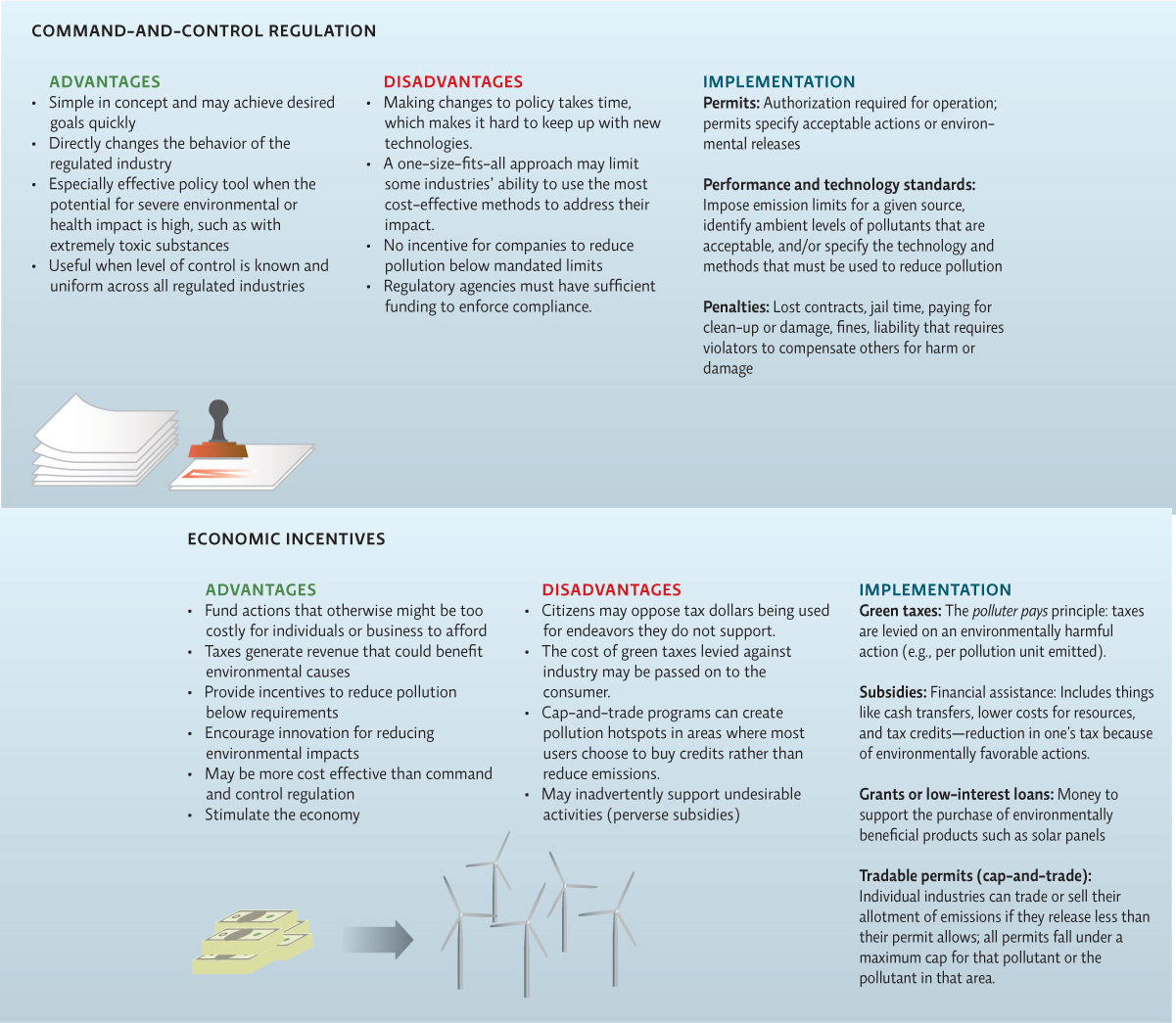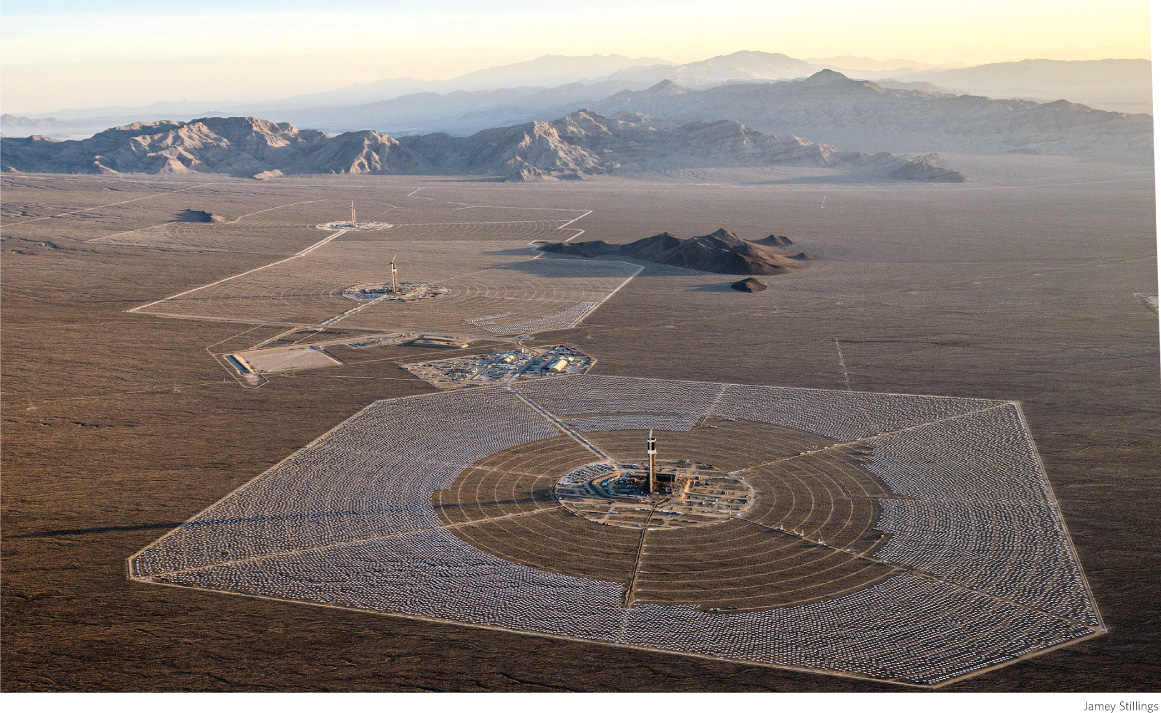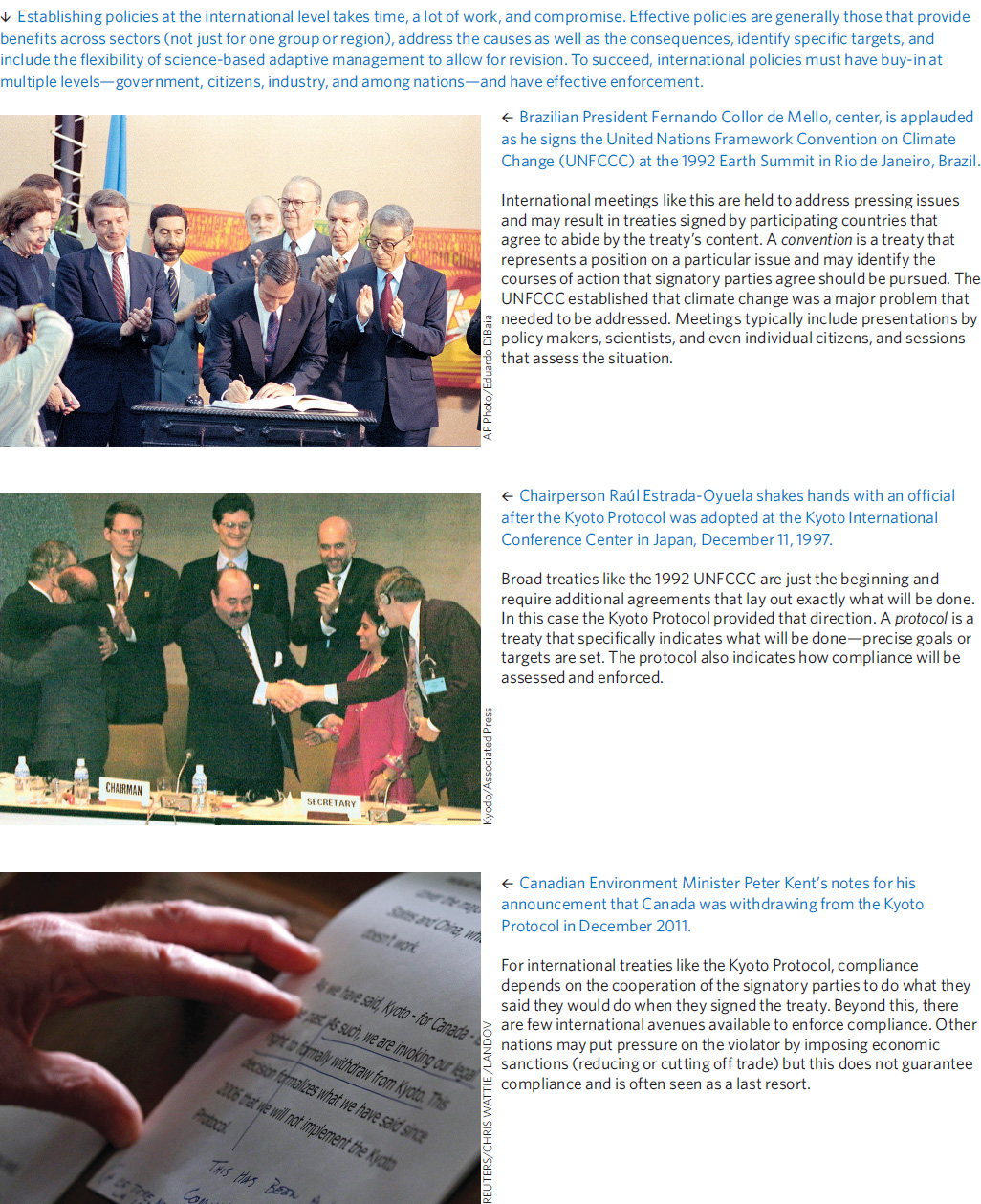A variety of policy tools are being used to address climate change.
In general, there are a range of policy tools that lawmakers use to protect the environment. Governmental command-and-control regulation is one approach. This can take several different forms: issuing permits to authorize operation or establishing performance standards that regulate emissions and specifying the practices that must be used to meet those standards.
policy tools
Methods that can be used to enforce or implement regulations or achieve desired outcomes.
command-and-control regulation
Regulations that set an upper allowable limit of pollution release which is enforced with fines and/or incarceration.
KEY CONCEPT 24.5
Policy can be enforced with command-and-control regulation or through economic incentives that favor preferred responses.
Alternatively, market-based approaches create economic incentives for the private sector to reduce environmentally harmful actions, without dictating exactly how to reach a desired target. For example, governments pursue the polluter pays principle when they levy taxes based on the amount of pollution produced—so-called green taxes. A different option is to reduce taxes by offering tax credits to consumers or businesses that pursue environmentally friendly actions—such as buying hybrid vehicles or installing energy-efficient equipment. Cap-and-trade policies represent another market-based approach. First used to successfully curb acid rain pollution in the 1990s, this method sets limits and distributes tradable permits for allowable emissions which businesses can freely trade to meet performance standards. Financial incentives such as subsidies, grants, and low-interest loans can also encourage environmentally beneficial actions that might otherwise be hard for individuals or businesses to afford. INFOGRAPHIC 24.4
green tax
A tax (a fee paid to the government) assessed on environmentally undesirable activities (e.g., a tax per unit of pollution emitted).
subsidies
Financial assistance given by a government or another party in support of actions that are expected to benefit the public good.


In general, which approach do you support to reduce our use of fossil fuel and other activities that contribute to climate change: command-and-control regulation or economic incentives?
Answers will vary but should be supported.
The HFC coolant policy that has proved so troublesome involves cap-and-trade as well as subsidies. It is part of the sluggish, decades-long path that constitutes the international attempt to address a warming climate. Its origins can be traced back to the United Nations Framework Convention on Climate Change (UNFCCC)—an international treaty that most experts say has been the foundation for global climate change policy. Born of the 1992 Earth Summit in Rio de Janeiro—a multinational, UN-led conference that set the stage for modern-era sustainable development and environmental stewardship—the UNFCCC was the first convention to formally recognize climate change as a serious emerging threat against which precautions should be taken. Its signatories—including the United States and 95 other nations—set themselves the lofty goal of stabilizing greenhouse gas emissions “at a level that would prevent dangerous anthropogenic [human-induced] interference with the climate system.”
United Nations Framework Convention on Climate Change (UNFCCC)
A 1992 international treaty that formally recognized climate change as an emerging problem and that said precautions should be taken to prevent dangerous anthropogenic interference with Earth’s climate system.

That treaty was only the beginning of a long, slow, deliberative process that involved myriad entities, and a seemingly endless stream of meetings, debates, negotiations, and votes. Agreeing that something needs to be done is one thing; coming to a consensus on what to do is another. Policy making, especially at the international level, is a painfully slow business. In fact, it took several years for the nations’ representatives participating in drafting the UNFCCC to establish a formal statement, essentially saying “we should do something about climate change.”
KEY CONCEPT 24.6
International policy is established though treaties that range from a simple agreement that action is needed to protocols that specify procedures and targets for participants.
After that came the Kyoto Protocol (1997), an international treaty that laid out exactly what that something is: specific greenhouse gas reduction targets, with deadlines. But agreeing on these targets was not easy. Debates raged for months and months, making international headlines each step of the way and frequently pitting the business sector against the environmentalist movement, scientists against policy makers, and countries against countries. At issue was how, exactly, to curb greenhouse gas emissions. INFOGRAPHIC 24.5
Kyoto Protocol
The 1997 amendment to the UNFCCC that set legally binding specific goals for reductions in greenhouse gas emissions for certain nations that ratified the treaty.

Kyodo/Associated Press
REUTERS/CHRIS WATTIE/LANDOV

There are different types of international agreements. In general, what is the difference between a convention treaty and a protocol treaty?
Convention are treaties that acknowledge a position on a particular topic (i.e. biodiversity is important; climate change should be addressed). Protocols are treaties that lay out specific actions for meeting specific goals that signatory countries agree to abide by.
Ultimately, countries like the United States and Great Britain that had historically released the most greenhouse gases were given much bigger reduction targets than other countries; in all, 37 developed nations and the European Union itself (called Annex 1 parties) were given specific reduction targets relative to their emissions in the baseline year, 1990. Because developing countries had not released as much in the past, and did not necessarily have the resources to reduce current emissions, they were not given any reduction targets.
KEY CONCEPT 24.7
International efforts to address climate change include the passage of a variety of treaties and the establishment of the IPCC to review climate science, but progress has been slow.
Developed nations—the United States especially— argued that this was unfair: If developing nations could burn more fossil fuels—and China and India were two developing nations that were burning lots of fossil fuels—they would gain an unfair advantage in the global marketplace; lucrative industries would desert us and flock to them. But developing nations were adamant: Emission caps of any kind would stunt their economic growth. Why should they have to bear even a fraction of the burden of reducing pollution that was caused almost exclusively by the developed, industrialized world? To address this divide, the Clean Development Mechanism was created by the Kyoto Protocol in 2003 to broker a compromise that would encourage both developed and developing countries to curb their emissions.
While the United States still declined to ratify Kyoto (the lack of specific reduction targets for all nations proved unacceptable to the members of the U.S. Senate, who rejected the Kyoto Protocol in a 97—0 vote), every other developed nation did sign on. Eventually, the CDM and its cap-and-trade system gave rise to an entire industry built around carbon credits. But it didn’t happen overnight. Like most other international environmental policies, Kyoto was designed to allow a gradual shift so that countries would have time to respond and the economy would not take too big a hit— and also so that adaptive technology could be developed that would make the tasks at hand easier to accomplish. This is a common approach: Treaties and protocols like Kyoto identify a target and then outline a robust time frame, replete with interim targets and deadlines, all in service to the ultimate goal—in this case, zero carbon emissions. INFOGRAPHIC 24.6
The international community has been grappling with climate change since 1979, when the first World Climate Conference was held. Though progress has been slow, recent meetings and treaties have focused on identifying the appropriate response for countries, setting emission-reduction targets, and establishing policies to help countries that are most vulnerable to the effects of climate change.


Do you feel that the international response aimed at addressing climate change has progressed at a reasonable pace, or has it progressed too slowly or too quickly? Explain.
Answers will vary but should be supported.
But as Wara and others know all too well, when policies are slow to move forward, problems are also slow to emerge.